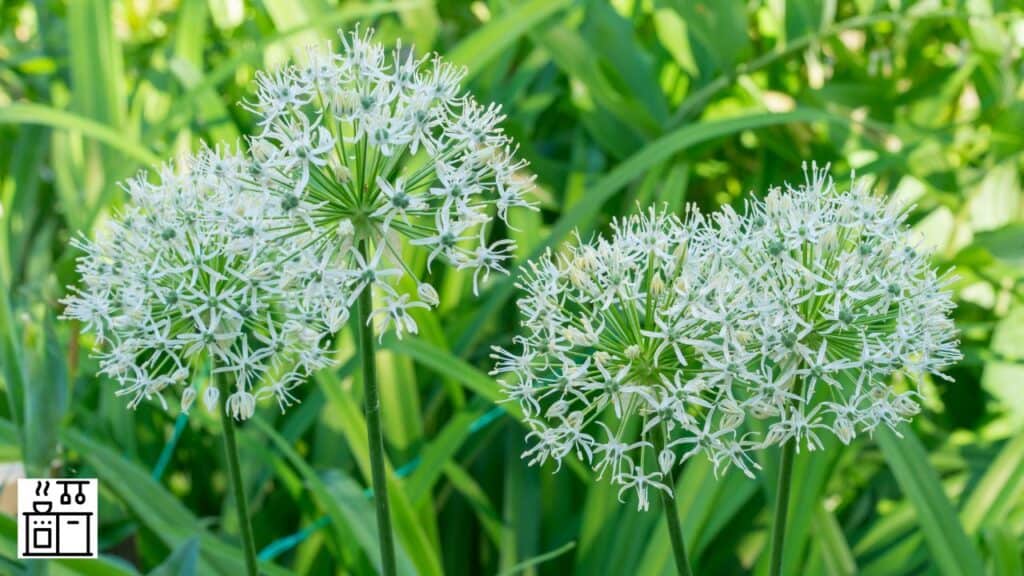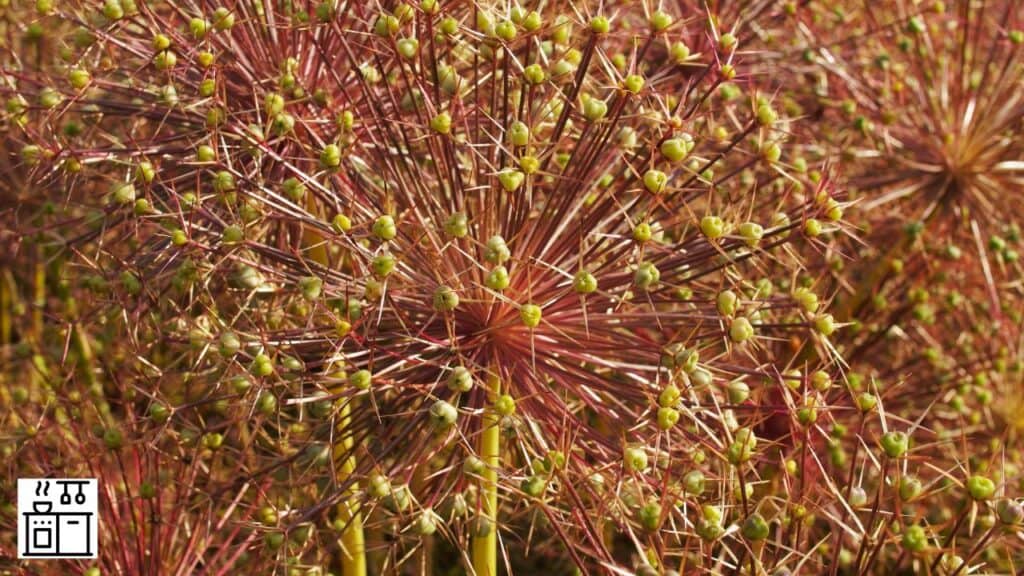Common varieties of onions will produce flowers and seeds only at the end of their life or under unfavorable environmental conditions.
However, some onions are specially grown for their beautiful blooms.
These ornamental onions are a prized addition to gardens. They’re highly valued for their decorative value.
Let’s take a closer look at these onion varieties.
10 Amazing Onions that Flower
Onions belong to the Allium family, which also includes shallots, garlic, and other bulbous plants.
This family also has monocotyledonous flowering plants that produce beautiful and long-lasting enormous flowers.
They can add bright and beautiful colors to a garden and become a focal point.
Here are some of these beautiful Allium varieties.
1. Blue Allium
True Blue Allium or Allium Azure produces beautiful blue flowers.
This plant originated in Siberia but is grown all over the world now.
The Blue Allium flowers occur as clusters.
Each flower has a star shape, while the cluster has a globular structure.
The flowers grow over an inch and add a beautiful pop of color to any garden setting.
This variety of Allium thrives when it gets a good amount of light. Hence, it does best in full sun.
The flowers usually bloom toward the end of spring or early summer and keep well for several weeks.
2. Moly
Allium Moly is also called Golden Garlic.
It’s a lovely perennial Allium variety that produces ornamental yellow flowers.
The flowers are star-shaped and grow on the stalks in bunches.
Interestingly, most parts of this plant, including the flowers, are edible.
The bulbs are delicious and taste good in salads and various other dishes.
Moly grows best in sunny spots. However, it tolerates the shade as well.
It’s a good plant for beginners because it will manage to grow with minimum care.
If you leave the flowers to wither away, the winds will carry the seeds to other parts of the garden, and you will have new Alliums next spring.
3. Allium Globemaster
Allium Globemaster is a showstopper onion that produces enormous round violet onion flowers.
The flower head is made of many tiny violet flowers that cluster to form a circle.
The flowers are spherical and have shaggy petals.
Each bulb head grows up to 10 inches in diameter, making it one of the largest flowers in the onion family.
The flowers bloom during spring and summer.
Globemaster flowers don’t smell like onions.
However, if you cut the stalk and smell it, it has a distinct oniony odor.
4. Millennium Onion
Millennium is a hybrid ornamental onion. This plant produces beautiful pink and purple globular flowers.
The flowers rise out of rhizome bulbs in the soil.
The stalks of this plant clump together to form a beautiful green bunch.
Flowers appear at the end of the stalks in a cluster. These bobbing heads are colorful and attractive.
One of the best things about Millennium onions is that each plant produces multiple clumps of flowers, whereas most Allium plants produce only one bulbous head per stalk.
So millennium plants look thicker. The plant blooms in mid-summer and lasts throughout the season.
5. Purple Sensation
Purple Sensation is a strikingly beautiful Allium. It produces stunning purple flowers.
It’s called the Persian onion or Dutch garlic and comes from Iran and Kyrgyzstan.
The flowers of this plant appear in clumps, with a dozen or more flowers per bunch.
It has a rich and shiny violet color with a fluorescent sheen adding to its appeal.
The leaves of this plant are a beautiful blue-green color. They’re thick and strap-like.
Purple Sensation flowers are used in flower arrangements for their beautiful color and long shelf-life.
6. Allium Mount Everest

As you can guess from the name, Allium Mount Everest produces gigantic onion flowers.
This majestic onion bloom bears fifty or more flowers on each stalk.
The flower heads are large, almost as big as baseballs.
Each flower is star-shaped with green specks.
The stems grow taller than other varieties and can reach up to 3 feet in height.
Hence, it’s one of the bigger onion flowers. The leaves have a greyish-green color.
These plants are hardy and thrive in well-drained sandy soil.
They don’t need frequent watering and hold up for several weeks.
The flowers usually appear between late spring and early summer and last till fall.
7. Drumstick Allium
Drumstick Allium flowers are different from other Allium varieties because they produce elongated clusters.
These flowers also appear in bunches.
However, they aren’t clumped together like a globe but instead have a longer egg-like shape.
When the flowers bloom, they’re green. Over time, they change into red and finally become purplish-brown.
The flowers thrive in full sunlight. They also need well-drained sandy soil that isn’t prone to water-logging.
The plant spreads through seeds and also grows from fall-planted bulbs.
If you want to contain the spread of this plant, remove the flowers before they disperse the seeds.
8. Chives
Chives are widely used in cooking.
The leaves and stems of these plants are edible and used as garnishes and ingredients for cooking.
However, the plant also produces edible flowers when it matures.
These flowers are also edible, and they taste best when they’re fresh and have just opened.
Chive flowers are bright purple. They appear in big bunches.
If you look closely, you will notice that each bunch has several flowers that stick together to look like a single flower.
There may be up to thirty flowers in each bunch. They bloom together to form a vivid purple ball.
The flowers appear in April and last for several weeks.
9. Karataviense
Allium Karataviense is a beautiful plant with leaves that are just as attractive as the flowers.
It’s also called the Turkistan onion and is a compact bulbous perennial onion plant.
This plant originated in Asia and is an unusual low-growing onion.
The onion plant bears large globes of pink and white star-shaped flowers.
Several flowers clump together to form a big globe-like structure.
The flowers have dark eyes, which creates a textured look for the flowers.
This plant requires more water than other varieties of Allium.
They smell sweet and bloom from late spring to summer.
The foliage is decorative with broad greyish-blue leaves with beautiful pink hues along their edges.
10. Pink Lily Leek
Pink Lily Leek is also called Allium Oreophilum.
The flowers of this onion plant aren’t like typical globe-like Allium flowers.
Instead, they’re compact, hardy bulbs with loosely spread, delicate rose star-shaped flowers.
The color of the flower ranges from light pink to rosy red or even bright fuchsia.
They pop against the dull greyish green stalks of the plant.
The leaves are narrow, long, and sturdy.
Although the flowers aren’t as big as other onion varieties, they have ornamental value and are widely chosen for rock gardens.
The Pink Lily Leek is easy to grow and maintain.
It thrives in nutrient-rich, composted soil.
The plant must be kept moist throughout the growing season.
It also needs full sun.
It profusely flowers and produces beautiful blooms when grown in sunny areas and provided with good nutrition and enough water.

